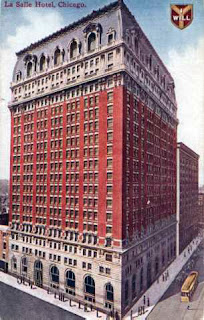click images for larger view (strongly recommended)
On December 30th, Dwayne's Photo in Parsons, Kansas, processed its final roll of Kodachrome film. It was the last lab in the world to process the distinctive film stock whose vivid colors defined, for most of its 75 year life, the look of America's captured family memories.About two weeks later, our correspondent Andy Pierce received his own package from Dwyane's - the prints of his last roll of undeveloped Kodachrome film. Andy had actually forgotten what was on it, and so he was pleasantly surprised to find out they were of the now lost Hotel LaSalle Garage, now the site of the distinctively-trussed residential tower whose name takes the address of the garage: 215 West Washington. Andy has graciously given us permission to share some of his striking, evocative photos of this distinctive work of Chicago architecture.
In the summer of 1918, the editor of the trade journal Hotel Monthly found himself "driven up what had every appearance of a mountain road, which rose in a spiral to the top of a five-story building."
The road is cement paved, ten feet wide, the spiral about 70 feet in diameter, and rising twelve feet to the floor; the grade one in twenty, or five per cent. About every 200 feet the road emerges onto the garage floor, where it is widened and level for the space between entrance and exit to the enclosed spiral. The driver tooted his horn to signal before entering or leaving each floor, the same as he would if turning a sharp corner on a mountain road. It took only about a minute to negotiate the hill between the ground and the fifth floor. An elevator large enough to take the biggest touring car is available for bringing the cars down. This elevator shaft rises inside the spiral roadway.The detail of the above description is almost comic. Hadn't this guy ever seen
a parking garage before?
The answer, of course, is no, probably not. This was the dawn of the automobile age, which more than any other factor, utterly transformed the American landscape and the urban experience. The spiral he saw was probably the first of its kind.
When the LaSalle Hotel, designed by Holabird and Roche, opened in 1909, horses and stables still held their own in the streets of the city. The 22-story-high, 1,000 room hotel was a true steel-framed skyscraper, but the Beaux Arts influence of the 1893 World's Fair still held sway. The swank LaSalle was built to host presidents - both Taft Coolidge stayed here - and above and below 11 floors of Chicago School-like brick curtain wall enclosing the tight honeycomb of guest rooms, French Second Empire was chosen as the most appropriate design mode. A massive Mansard roof capped the building's crown.
When, less than a decade later, it came time to accommodate not only guests but their automobiles as well, Holabird and Roche were called upon again, this time to design a parking garage about a block and a half from the hotel. The garage tracked its guest the same way as the hotel, using the recently developed "room rack" system of ledger cards, one for each compartment, but since the inhabitants of the garage were not people but their machines, the facades of the garage echoed, not the hotel's overstuffed ostentation, but the clean lines of a classic Loop office building.. As described by the AIA Guide to Chicago:
. . . there is nothing conventional about the way the fifteen narrow bays with their sash windows alternate with the vigorous uninterrupted piers. The wonderful rhythm is enhanced by the use of black Roman bricks as striping in the red facade and by crisply detailed spandrel panels. A stringcourse above the shops and a well-proportioned cornice contain the design.The AIA called it an "uncelebrated gem." The city called it road kill. Preservationists lobbied energetically to save it. The staff of the Landmarks Commission prepared a report documenting its value. Then the usual developers dance began. Delay followed delay, as the owner resisted and allowed the building to continue to rot, so by the time the Planning Department brought down its heavy hand in November of 2004 to smash the Commission's efforts, all the parties that had actively abetted the garage's deterioration could shed crocodile tears, "Boo hoo, boo hoo. Maybe it was worth saving, but golly gee, it's falling apart and now we have no choice but to gird our loins and let it die." Rinse and repeat. (See: the Farwell Building and Van Osdel's 1894 YMCA Hotel.)
When Andy Pierce took the Kodachrome shots you see here, the building was already something of a spectre. Somehow I doubt "1950's rec room" was the original style.
. . . although the locksmith's shack with the "Wanted" posters was actually a rather charming addition.
You could see that the place was already living on borrowed time.
. . . which became even more clear after it had been emptied out just before demolition.
With their faded Kodachrome palette, Andy's shots seem to capture the aura of the 21 grams - the supposed weight of the soul - lingering in the air, invisible but insistent, for those last few heartbeats before the thing dissolves before your eyes and vanishes forever.













3 comments:
My office is right next door. The garage was far more interesting a structure than the condo tower that replaced it, but that's probably just my love of the archaic talking.
Incredible. I love the description of the parking garage!
I passed by the deconstruction sight every day on the way to/from work, taking a picture most days. I wanted to document the teardown somehow, but never did anything with the photos...
Post a Comment